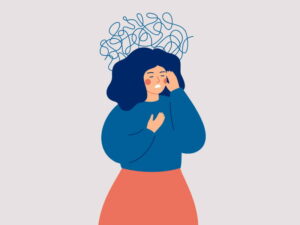Panic attacks can be overwhelmingly intense, often creating waves of fear that make individuals feel out of control. While the experience is unsettling, it’s essential to understand that you’re not alone, and there are proven methods to manage and even reduce these occurrences. One such powerful tool is Cognitive Behavioral Therapy (CBT), a therapeutic approach that targets the way we think and behave. In this blog, we’ll delve deep into understanding panic attacks and how CBT can offer a lifeline to those grappling with them.
Contents
Does CBT Help With Panic Attacks?
 Cognitive Behavioral Therapy (CBT) is one of the most researched and validated forms of therapy for addressing panic attacks. It operates on the principle that our thoughts, emotions, and behaviors are interconnected. For individuals with panic disorder, CBT helps them recognize and challenge irrational fears and beliefs that trigger or contribute to panic attacks. This aids in decreasing the intensity and frequency of the attacks. And also equips individuals with tools to cope when they do occur.
Cognitive Behavioral Therapy (CBT) is one of the most researched and validated forms of therapy for addressing panic attacks. It operates on the principle that our thoughts, emotions, and behaviors are interconnected. For individuals with panic disorder, CBT helps them recognize and challenge irrational fears and beliefs that trigger or contribute to panic attacks. This aids in decreasing the intensity and frequency of the attacks. And also equips individuals with tools to cope when they do occur.
In addition to cognitive restructuring, CBT often incorporates exposure therapy for panic disorder. This involves gradually and safely exposing individuals to the physical sensations of a panic attack in a controlled environment. Over time, this reduces the fear associated with these sensations and minimizes the panic response.
What Techniques Are Used In CBT For Panic Attacks?
CBT for panic attacks employs a variety of techniques to help individuals understand, challenge, and change their thought patterns and behaviors that contribute to the attacks. Here are some of the primary techniques used:
Cognitive Restructuring
This technique involves identifying and challenging irrational or negative beliefs and thoughts that contribute to panic. Once these thoughts are identified, the individual is taught to replace them with more balanced and rational thoughts.
Exposure Therapy
Here, individuals are gradually and safely exposed to the physical sensations they fear in a controlled setting. This might include intentional hyperventilation or spinning in a chair to induce dizziness. The aim is to reduce the fear of these sensations by familiarizing the person with them and teaching coping mechanisms.
Breathing Retraining
Hyperventilation can lead to symptoms like dizziness and lightheadedness, which can exacerbate panic. By teaching individuals to breathe slowly and deeply from the diaphragm, they can counteract the body’s panic response.
Interoceptive Exposure
This involves safely inducing the sensations of a panic attack to help individuals become less sensitive to them. Over time, they recognize that these sensations are not dangerous and can manage their reactions to them.
Behavioral Experiments
These are “real-life tests” where individuals challenge their beliefs by putting them to the test in the real world. For instance, if someone believes they’ll faint during a panic attack, they might be encouraged to spin around to feel dizzy, demonstrating that dizziness doesn’t necessarily lead to fainting.
Journaling or Thought Records
Keeping a diary of triggers, thoughts, feelings, and behaviors related to panic attacks can help individuals identify patterns and track their progress over time.
Psychoeducation
Understanding the physiology of panic attacks can be reassuring for many. By learning about the body’s “fight or flight” response and how it can sometimes misfire, individuals can demystify the experience of a panic attack.
Mindfulness and Grounding Techniques
These techniques, including the “5-4-3-2-1” grounding exercise, help bring the individual back to the present moment during or after a panic attack.
Each individual might benefit differently from these techniques. A trained therapist will tailor the approach based on the person’s unique needs and progress.
How Many CBT Sessions For Panic Attacks?
 The number of CBT sessions required for treating panic attacks can vary widely. This is based on the individual’s severity of symptoms, their responsiveness to therapy, the presence of co-existing mental health conditions, and other individual factors. However, CBT is generally considered a short-term therapeutic approach.
The number of CBT sessions required for treating panic attacks can vary widely. This is based on the individual’s severity of symptoms, their responsiveness to therapy, the presence of co-existing mental health conditions, and other individual factors. However, CBT is generally considered a short-term therapeutic approach.
For many people with panic disorder:
- Standard Treatment: Typically, a course of CBT for panic attacks ranges from 8 to 15 sessions, with each session lasting about 50 minutes to an hour. This provides enough time to cover the foundational CBT techniques, practice them, and make adjustments based on the individual’s progress.
- Intensive Treatment: For those who need more immediate results or have a more severe presentation, there are intensive CBT programs where individuals might attend therapy multiple times a week for several weeks.
- Maintenance Sessions: After the initial course of therapy, some individuals benefit from occasional “booster” sessions to reinforce skills, address any recurring concerns, or manage other life stressors that could trigger a return of symptoms.
It’s important to note that many people benefit significantly from this range of sessions. Still, some might require fewer, and others might benefit from extended therapy, especially if there are additional issues to address. Ultimately, the number of sessions required should be determined collaboratively between the individual and their therapist based on the individual’s unique needs.
What Are The Pros And Cons Of CBT For Panic Attacks?
Like any therapeutic method, it comes with its advantages and limitations. Here’s a breakdown of the pros and cons of using CBT for panic attacks:
Pros
- Evidence-Based: CBT has a robust body of research supporting its effectiveness in treating panic attacks and panic disorder. Multiple studies have shown a significant reduction in symptoms for many individuals.
- Structured and Goal-Oriented: CBT is typically short-term and focuses on specific goals, making it a time-efficient approach for many.
- Teaches Practical Skills: CBT empowers individuals with practical tools and strategies to manage their symptoms, which can be used long after therapy ends.
- Promotes Self-awareness: Through CBT, individuals gain insight into their thought patterns, behaviors, and triggers, leading to greater self-understanding and proactive management of symptoms.
- Applicable to Other Issues: The skills learned in CBT can be applied to other areas of one’s life, such as managing stress, improving relationships, or addressing other mental health concerns.
- Low Risk: Unlike medication, CBT does not have side effects related to drug interactions or long-term use.
Cons
- Requires Active Participation: CBT is not a passive form of therapy. It demands active engagement, homework, and practice outside of sessions, which might not suit everyone.
- Not Always Immediately Effective: Some individuals might feel overwhelmed or anxious when first facing their fears or when initially trying out new strategies.
- Not Suitable for Everyone: While many benefit from CBT, it might not be the best fit for everyone. Some individuals might have underlying issues or trauma that need a different therapeutic approach.
- Access and Cost: Not everyone has access to trained CBT therapists. And the cost of therapy can be a barrier for some.
- Reliance on Therapist’s Skill: The effectiveness of CBT can be influenced by the therapist’s expertise. A therapist who isn’t well-versed in CBT techniques might not offer the same benefits as one who specializes in this approach.
Therefore, while CBT offers numerous benefits for treating panic attacks, it’s essential to consider individual preferences, needs, and circumstances. Consulting with a mental health professional can provide a clearer picture of whether CBT is the right choice for a particular individual.
How Successful Is CBT For Panic Attacks?
 Cognitive Behavioral Therapy (CBT) is one of the most effective treatments for panic attacks and panic disorder. Numerous research studies have shown its success in reducing or even eliminating the frequency and severity of panic attacks. Clinical trials have demonstrated that approximately 70-90% of individuals undergoing CBT for panic disorder experience significant benefits. And, showing a marked reduction in the occurrence and intensity of panic attacks.
Cognitive Behavioral Therapy (CBT) is one of the most effective treatments for panic attacks and panic disorder. Numerous research studies have shown its success in reducing or even eliminating the frequency and severity of panic attacks. Clinical trials have demonstrated that approximately 70-90% of individuals undergoing CBT for panic disorder experience significant benefits. And, showing a marked reduction in the occurrence and intensity of panic attacks.
Furthermore, these benefits tend to be long-lasting, with many individuals maintaining their gains after the therapy ends. However, success varies depending on individual circumstances, the presence of co-morbid conditions, and the expertise of the therapist. While the majority of individuals benefit significantly from CBT, some might require adjunctive treatments like medication to achieve optimal results.
It’s also worth noting that consistent practice of the strategies learned in CBT is essential for long-term success. Hence, individuals are encouraged to actively engage in the therapeutic process to maximize its efficacy.
Conclusion
In the quest to understand and manage panic attacks, Cognitive Behavioral Therapy (CBT) stands out as a beacon of hope for many. CBT offers a structured and empowering approach to tackle the crippling effects of panic attacks. By focusing on altering negative thought patterns and behaviors, individuals witness a marked reduction in the frequency and severity of their attacks. And also gain invaluable skills that serve them well in various life situations.
While individual experiences may vary, the overarching narrative remains clear: with commitment, guidance, and consistent practice, overcoming panic attacks with CBT is a very attainable goal. If you are experiencing anxiety-related issues, Online Anxiety Counseling in India at TherapyMantra can help: Book a trial Online therapy session


